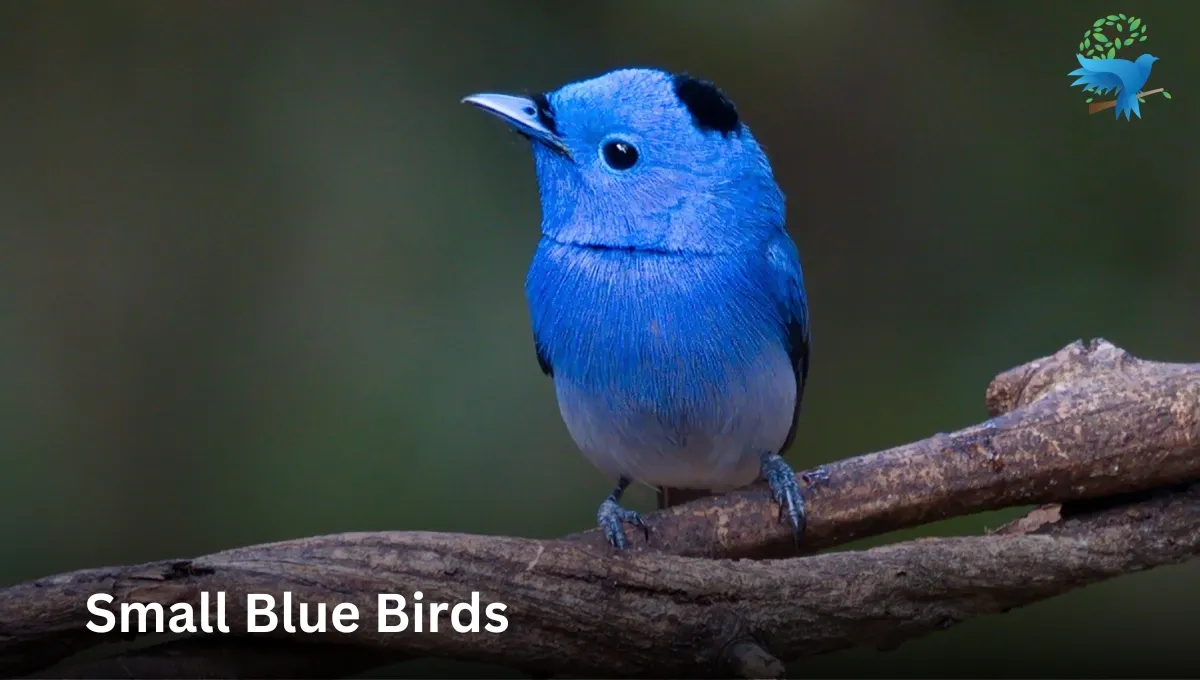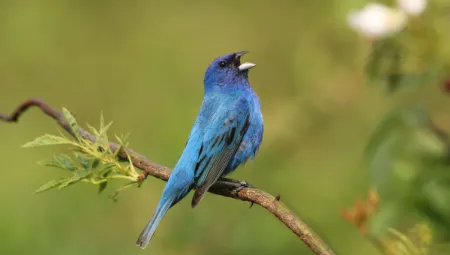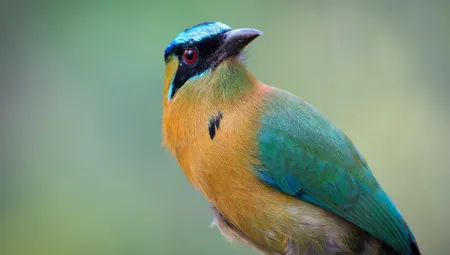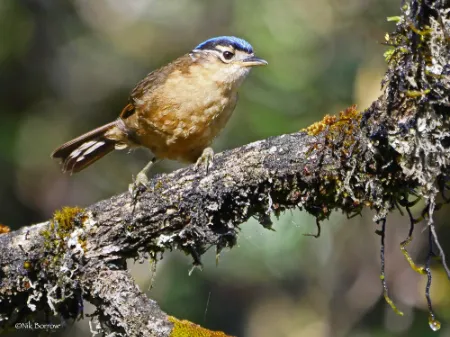Small Blue Birds

Blue is one of the most peaceful colors, and it makes sense that we find blue birds to be some of the most calm and relaxing birds around. But, it is not as common a color to see on birds.
This is because blue as a pigment simply does not exist there. They have to use other means to be perceived as blue. In this article, we have included 15 types of small blue birds and their descriptions.
Small Blue Birds
1. Eastern Bluebird (Sialia sialis)

Short Description of the Bird
The Eastern Bluebird is a small songbird, larger than a sparrow but smaller than a robin. It has a big and round head, large eyes, and a round body, with a short bill, legs, tail, and slightly extended wings.
Male bluebirds have a bright head, back, and wings. Their breast is a brownish red. Females are lighter, with gray on the head and back and some blue on their wings and tail. In females, the breast is generally lighter than in males and is more orange.
Habitat
It is native to North America and is commonly found in open woodlands, parks, and backyards throughout eastern North America. Their habitat consists of open and semi-open areas with sparse ground cover and perches for insect hunting.
Feeding Habits
Throughout the year, they consume insects and spiders. During the winter, their diet expands to include fruit.
2. Mountain Bluebird (Sialia currucoides)

Short Description of the Bird
The male Mountain Bluebird is a stunning electric blue bird with a white belly. The wings and tail are darker, the underside is paler, and the wing and tail tips are darker grey.
On the other hand, the female is grey-brown with lighter underparts and blue on the wings and tail. They also have a whitish eye ring, and in certain cases, females have rufous on the chest.
Habitat
The Mountain Bluebird is native to the western mountain regions of North America. They breed in high mountain meadows with scattered trees and bushes and short grass. During harsh winters, they migrate south to areas like Mexico. Their habitats include grasslands, forests, and shrublands.
Feeding Habits
Primarily, their diet consists of insects. They supplement their diet with spiders, fruits, and seeds in winter.
3. Indigo Bunting (Passerina cyanea)

Short Description of the Bird
It is a smallish songbird, around the size of a small sparrow. The male is vibrant blue in the summer and brown during the winter months, while the female is brown year-round.
Habitat
The Indigo Bunting primarily inhabits brushy forest edges, open deciduous woods, second-growth woodland, and farmland. They favor nestling in roadsides, old fields growing up to bushes, edges of woodlands, and other edge habitats.
Feeding Habits
The diet of the Indigo Bunting consists mostly of insects during the summer months and seeds during the winter months.
4. Blue Jay (Cyanocitta cristata)

Short Description of the Bird
It is a blue and white bird with a large crest. Their upper parts are bright blue, and the underparts are greyish-white. Blue Jay has a distinct black necklace, white wing bars, and black barring on the wings and tail. The face is white with black in front of the eye, and the crest is grey-blue.
Habitat
Throughout the year, they occur in the eastern United States and southern Canada. They live in woodlands, forests, parks, and yards.
Feeding Habits
Its diets include insects, nuts, fruits, and seeds. They occasionally feed on grains, eggs, and nestlings.
5. Blue-headed Vireo (Vireo solitarius)

Short Description of the Bird
Blue-headed Vireo is a Neotropical migrating bird. It is characterized by its blue-grey head and bold yellow wing bars. Both sexes are very similar in plumage and size. Also, juveniles have a similar plumage.
Habitat
Large temperate forests with a mix of evergreen trees and deciduous under growth.
Feeding Habit
Blue-headed vireos are mostly insectivorous birds but also eat fleshy berries and fruit.
6. Blue Grosbeak (Passerina caerulea)

Short Description of the Bird
Blue Grosbeak is a North American passerine bird. The male is blue with two brown wing bars. The female is mostly brown with scattered blue feathers on the upperparts and two brown wing bars.
Habitat
Blue Grosbeak occurs in the southern and central United States and northern Mexico during summer and in southern Mexico and Central America during winter. Its natural habitats are overgrown fields, forest edges, hedgerows, deserts, streamside thickets, savannas, and forests.
Feeding Habit
Their diet mainly consists of insects, but they also take spiders, seeds, grains, and snails.
7. Lazuli Bunting (Passerina amoena)

Short Description of the Bird
Lazuli Bunting is a small, finch-like songbird. The male is recognized by its bright blue head and back, white wingbars, and light rusty breast. The female is brown, grayer above and warmer underneath.
Habitat
It is a migratory bird that breeds in the northwestern US and Canada and winters in Arizona and western Mexico. Their habitats range from brushy hillsides and ravines to wooded valleys, thickets, scrublands, weedy pastures, agricultural areas, yards, and streamside locations.
Feeding Habit
This species feeds on seeds, insects, spiders, and fruits.
8. Varied Bunting (Passerina versicolor)

Short Description of the Bird
Varied Bunting is a species of songbird in the cardinal family. Adult male are a stunning mosaic of rich plum, crimson, cherry red, and lavender-violet. On the other hand, females and immature are brownish.
Habitat
It inhabits deserts and xeric shrublands, preferring thorny brush thickets, thorn forests, scrubby woodlands, and overgrown clearings.
Feeding Habit
They forage on the ground for fruit, seeds, and insects.
9. Cerulean Warbler (Setophaga cerulea)

Short Description of the Bird
Cerulean Warbler is a family of Parulidae. The male is a striking sky blue that can even appear turquoise in the right light. It has a white throat and black streaking. While females appear different with yellow feathers that have a slight blue wash.
Habitat
They stay in deciduous forests during summer, tropical forests, plantations, and scrublands during migration, and evergreen woodlands, forests, and shade-grown coffee plantations at their wintering grounds.
Feeding Habit
Their primary diet consists of insects and also eat plant matter in winter.
10. Blue-gray Gnatcatcher(Polooptila caerulea)

Short Description of the Bird
Blue-gray Gnatcatcher is a native of North America. The males are blue-gray on the upperparts with white underparts, slender dark bill, and long black tail edged in white. While females are less blue and juveniles are greenish-gray. Also, both sexes have a white eye ring.
Habitat
It enjoys a wider range of woodland habitats, from shrublands to mature forests.
Feeding Habit
They mainly eat insects, insect eggs, and spiders.
11. Blue-crowned Motmot (Momotus momota)

Short Description of the Bird
It is a colorful near-passerine bird in the family Momotidae. It has a black eyemask, a blue crown atop its head, green wings, and long tail feathers. Likewise, it is very easy to recognize by its long, bright blue racquet-shaped tail feathers which it swings from side to side when it is distributed.
Habitat
They are found in eastern Mexico. Within this range, motmots live in the rainforest, tropical dry forest, and woodland, usually near the water.
Feeding Habit
They eat small prey such as insects and lizards, and will also regularly take fruit.
12. Azure Tit(Cyanistes cyanus)

Short Description of the Bird
Azure Tit bird head, tail corners, wings bars, and underparts are white, while the upperparts are blue. Also, it has a distinctive dark line running through its eye.
Habitat
Azure tit is a widespread resident breeder throughout Russia, Central Asia, northwest China, Manchuria, and Pakistan. It is found in temperate and subarctic deciduous or mixed woodlands, scrub, and marshes.
Feeding Habit
They feed on insects, seeds, small invertebrates, bug larvae, and eggs.
13. Blue-throated Bee-eater (Merops viridis)

Short Description of the Bird
Blue-throated Bee-eater are small birds with colorful plumage. They have a red nape, dark green wings, light green breast, and their signature blue throat. Juveniles have dark green head and wings and light green breasts, only developing their full adult plumage later.
Habitat
They are often seen in Southeast Asia in subtropical or tropical mangrove forests.
Feeding Habit
Their diet includes bees, wasps, and dragonflies.
14. Blue-capped lfrita (Ifrita kowaldi)

Short Description of the Bird
Blue-capped ifrita is an insectivorous passerine. Its plumage is yellowish brown with a blue-black crown atop its broad head. Also, it is a sexually dimorphic species, with ear streak coloration being white in males and more tawny yellow in females.
Habitat
It inhabits montane rainforest of New Guinea, living in altitude ranges of 1000-4000m above sea level.
Feeding Habit
It feeds on insects, sometimes on soft fruits.
15. Blue-faced Parrotfinch (Erythrura trichroa)

Short Description of the Bird
The Blue-faced Parrotfinch is a small bird, with males is multi-shaded with colors ranging from light yellow-green to dark blue-green. There are deep blue feathers on their forehead and face, and their tails are normally red to rusty red-brown. While females are covered with a less vibrant blue and are a bit smaller and have more rounded heads.
Habitat
Its prefer rainforest edges and dense graslands that have woody plants, and also they prefer to roost in rainforests.
Feeding Habit
They feed on grass and bamboo seeds, small insects, and figs.






